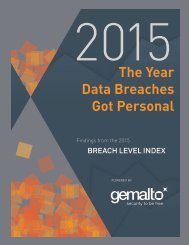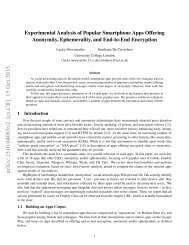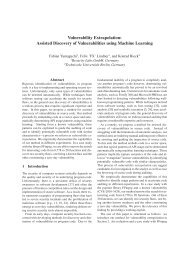Deobfuscating Embedded Malware using Probable-Plaintext Attacks
Deobfuscating Embedded Malware using Probable-Plaintext Attacks
Deobfuscating Embedded Malware using Probable-Plaintext Attacks
Create successful ePaper yourself
Turn your PDF publications into a flip-book with our unique Google optimized e-Paper software.
2 <strong>Deobfuscating</strong> <strong>Embedded</strong> <strong>Malware</strong> <strong>using</strong> <strong>Probable</strong>-<strong>Plaintext</strong> <strong>Attacks</strong><br />
strategies, many attackers resort to simple cryptographic ciphers when implementing<br />
the first obfuscation layer in native code. Often these ciphers are variants<br />
of the so-called Vigenère cipher <strong>using</strong> XOR and ADD/SUB instructions for<br />
substitution and ROL/ROR for transposition. The resulting code can fit into<br />
less than 100 bytes and, in contrast to strong ciphers, exposes almost no detectable<br />
patterns in the documents [see 4]. As an example, Figure 1 shows a<br />
simple deobfuscation loop <strong>using</strong> XOR that fits into 28 bytes.<br />
Due to the simplicity and small size, such native code seems sufficient for<br />
a first obfuscation layer, yet the resulting encryption is far from being cryptographically<br />
strong. For short keys up to 2 bytes the obfuscation can be trivially<br />
broken <strong>using</strong> brute-force attacks. However, uncovering malware obfuscated with<br />
longer keys, as for example the 4-byte key in Figure 1, still necessitates manually<br />
reverse engineering the code or dynamically analyzing the malicious document<br />
in a sandbox with vulnerable versions of the target application [e.g., 7, 17, 20].<br />
While both approaches are effective in removing the obfuscation layer, they require<br />
a considerable amount of time in practice and are thus not suitable for<br />
analyzing and detecting embedded malware at end hosts.<br />
In this paper, we present Kandi, a method capable of efficiently breaking<br />
Vigenère-based obfuscations and automatically uncovering embedded malware<br />
in documents without the need to parse the document’s file format. The method<br />
leverages concepts from classic cryptography in order to conduct a probableplaintext<br />
attack against common variants of the Vigenère cipher. To this end,<br />
the method first approximates the length of possible keys and then computes<br />
so-called difference streams of the document and plaintexts likely contained in<br />
malware binaries. These plaintexts are automatically retrieved beforehand and<br />
may include fragments of the PE header, library names and common code stubs.<br />
Using these streams it is possible to look for the plaintexts directly in the obfuscated<br />
data. If sufficient matches are identified, Kandi automatically derives<br />
the obfuscation key and reveals the full embedded code for further analysis, for<br />
example, by an anti-virus scanner or a human expert.<br />
We demonstrate the efficacy of this approach in an empirical evaluation with<br />
documents of different formats and real malware. In a controlled experiment<br />
Kandi is able to break obfuscations <strong>using</strong> XOR and ADD/SUB with keys up<br />
to 13 bytes. On a collection of real-world malware in Word, Powerpoint and<br />
RTF documents with unknown obfuscation, Kandi is able to deobfuscate every<br />
fourth document and exposes the contained malware binary, including several<br />
00: be XX XX XX XX mov edx, ADDRESS<br />
05: 31 db xor ebx, ebx<br />
07: 81 34 1e XX XX XX XX start: xor dword [edx + ebx], KEY<br />
0e: 81 c3 04 00 00 00 add ebx, 0x04<br />
14: 81 fb XX XX XX XX cmp ebx, LENGTH<br />
1a: 7c eb jl start<br />
Fig. 1. Example of native code for a Vigenère-based obfuscation. The code snippet<br />
deobfuscates data at ADDRESS of length LENGTH <strong>using</strong> the 4-byte key KEY. For simplicity<br />
we omit common tricks to avoid null bytes in the code.









